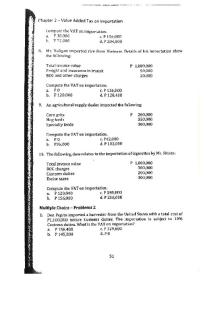Phys 103 Chapter 3 - Lecture notes 3 PDF

| Title | Phys 103 Chapter 3 - Lecture notes 3 |
|---|---|
| Course | How Things Work |
| Institution | Towson University |
| Pages | 3 |
| File Size | 65.2 KB |
| File Type | |
| Total Downloads | 57 |
| Total Views | 186 |
Summary
Acceleration & Motion , Professor Lally...
Description
Acceleration, a a = (change in velocity) / time a = (vf - vi) / t Note that the i and f are subscripts. The units here are m/s^2, or m/s/s. Acceleration is a measure of how quickly you change your speed - that is, it's a measure of 'change in speed' per time. Imagine if you got in a car and floored it, then could watch your speedometer. Imagine now that you get up to 10 miles/hr (MPH) after 1 second, 20 MPH by the 2nd second, 30 MPH by the 3rd second, and so on. This would give you an acceleration of: 10 MPH per second. That's not a super convenient unit, but you get the idea (I hope!). > The equations of motion
Recall v = d/t. That's usually how we calculate average velocity. However, there is another way to compute average velocity: v = (vi + vf) / 2 where vi is the initial velocity, and vf is the final (or current) velocity. This is the same as taking the average of two numbers, in this case, the initial and final velocities. Knowing these equations for average velocity, as well as the definition for acceleration, allows you to relate (or calculate) the interesting things about an object's motion: initial velocity, final velocity, displacement, acceleration, and time. As it happens, you can do a bunch of algebra to put the equations together into more convenient forms. I will do this for you and summarize the most useful equations. In general, there are 2 or 3 really useful equations for accelerated motion. Today we will chat about the equations of motion. There are 4 very useful expressions that relate the variables in questions: vi - initial velocity vf - velocity after some period of time a - acceleration t - time d - displacement Now these equations are a little tricky to come up with - we can derive them in class, if you like. (Remember, never drink and derive. But anyway....) We start with 3 definitions, two of which are for average velocity:
v (avg) = d / t v (avg) = (vi + vf) / 2 and the definition of acceleration: a = (change in v) / t or a = (vf - vi) / t Through the miracle of algebra, these can be manipulated (details shown, if you like) to come up with: vf = vi + at d = 0.5 (vi + vf) t d = vi t + 0.5 at^2 vf^2 = vi^2 + 2ad
Note that in each of the 4 equations, one main variable is absent. Each equation is true - indeed, they are the logical result of our definitions - however, each is not always helpful or relevant. The expression you use will depend on the situation. By the way, there is a 5th equation of motion (d = vf t - 0.5 at^2) that is sometimes useful. We won't need it in this class.)
In general, I find these most useful:
vf = vi + at d = 0.5 (vi + vf) t d = vi t + 0.5 at^2 By the way, note that the 2nd equation above is the SAME THING as saying distance equals average velocity [0.5 (vi + vf)] multiplied by time. Also, if the initial velocity is zero (as it usually is in our problems), the equations become even simpler:
vf = at
d = 0.5 (vf) t d = 0.5 at^2...
Similar Free PDFs

Lecture 3 Phys 2130
- 6 Pages

Chapter 3 - Lecture notes 3
- 1 Pages

Chapter 3 - Lecture notes 3
- 30 Pages

Chapter 3 - Lecture notes 3
- 6 Pages

Chapter 3 - Lecture notes 3
- 6 Pages

Chapter 3 - Lecture notes 3
- 45 Pages

Chapter 3 - Lecture notes 3
- 5 Pages

Chapter 3 - Lecture notes 3
- 4 Pages

Chapter 3 - Lecture notes 3
- 4 Pages

Chapter 3 - Lecture notes 3
- 4 Pages

Chapter 3 - Lecture notes 3
- 3 Pages

Chapter 3 - Lecture notes 3
- 3 Pages

Chapter 3 - Lecture notes 3
- 24 Pages
Popular Institutions
- Tinajero National High School - Annex
- Politeknik Caltex Riau
- Yokohama City University
- SGT University
- University of Al-Qadisiyah
- Divine Word College of Vigan
- Techniek College Rotterdam
- Universidade de Santiago
- Universiti Teknologi MARA Cawangan Johor Kampus Pasir Gudang
- Poltekkes Kemenkes Yogyakarta
- Baguio City National High School
- Colegio san marcos
- preparatoria uno
- Centro de Bachillerato Tecnológico Industrial y de Servicios No. 107
- Dalian Maritime University
- Quang Trung Secondary School
- Colegio Tecnológico en Informática
- Corporación Regional de Educación Superior
- Grupo CEDVA
- Dar Al Uloom University
- Centro de Estudios Preuniversitarios de la Universidad Nacional de Ingeniería
- 上智大学
- Aakash International School, Nuna Majara
- San Felipe Neri Catholic School
- Kang Chiao International School - New Taipei City
- Misamis Occidental National High School
- Institución Educativa Escuela Normal Juan Ladrilleros
- Kolehiyo ng Pantukan
- Batanes State College
- Instituto Continental
- Sekolah Menengah Kejuruan Kesehatan Kaltara (Tarakan)
- Colegio de La Inmaculada Concepcion - Cebu


